Scientific classification
Kingdom:
Phylum:
Mollusca
Class:
Bivalvia
Order:
Limoida
Family:
Limidae
Genus:
Limaria
Species:
L. Hians
Binomial name (link Wikipedia)




File Shell
Lime- Limaria Hians
Feilenmuschel
Limaria Hians
Vijlmossel
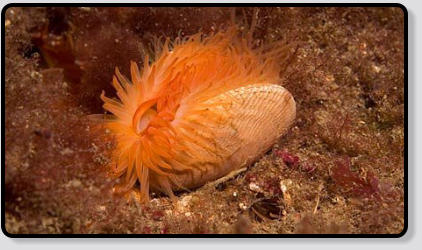
Description
The flame shell, scientific name Limaria hians, is a species of small saltwater clam, a marine bivalve mollusc in the family Limidae. This species
is native to the northeastern Atlantic Ocean.
This species is found in the northeast Atlantic, ranging from Lofoten to the Canary Islands, including the Mediterranean Sea. In the British Isles,
the distribution of this species is primarily in the west coast of Scotland from the sublittoral (below low tide), down to 100m, although there are
patchy records of the species being found in more southerly regions of the United Kingdom. There are a number of well-known colonies on the
sea bed in Loch Carron, below Strome Castle. In 2012 a bed of 100 million flame shells covering an area of 75 hectares was found during a
survey of Loch Alsh undertaken by Heriot-Watt University on behalf of Marine Scotland. Richard Lochhead, Cabinet Secretary for Rural Affairs
and the Environment said: "The flame shell must be considered among the most remarkable species in our waters, with a dazzling array of
orange tentacles. Many would place such an exotic species in far-flung tropical reefs - not realising they dwell under the waves just off the coast
of Skye. This important discovery may be the largest grouping of flame shells anywhere in the world."

Animalia
Scientific classification
Kingdom:
Phylum:
Mollusca
Class:
Bivalvia
Order:
Pectinoida
Family:
Pectinidae
Genus:
Manupecten
Species:
M. Pesfelis
Manupecten Pesfelis
Binomial name




Manupecten Pesfelis
Manupecten Pesfelis
Manupecten Pesfelis
Manupecten Pesfelis
Manupecten Pesfelis
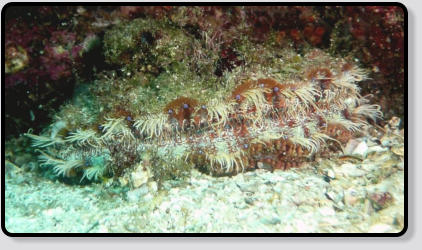
Description
Manupecten pesfelis is a species of bivalve molluscs the Pectinidae.
The scientific name of the species is valid for the first time published in 1758 by Linnaeus.
No further information available on Wikipedia.
Animalia
Scientific classification
Kingdom:
Phylum:
Mollusca
Class:
Bivalvia
Order:
Pterioida
Family:
Pinnidae
Genus:
Pinna
Species:
P. Rudis
Binomial name (link Wikipedia)




Spiny Fan-Mussel
Pinne
Stachelige Steckmuschel
Abanico-Peineta
Pen Mossel
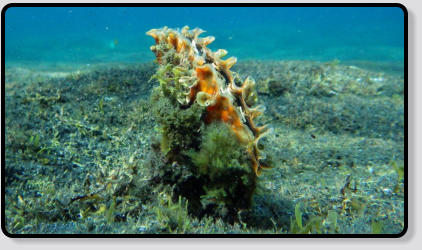
Description
Pinna rudis, the rough pen shell or spiny fan-mussel, is a species of bivalve mollusc in the family Pinnidae. It is the type species of the genus
Pinna. Knowledge about this is sparse, with an absence of specific studies and literature.
P. rudis has a shell that commonly reaches a length of 25–30 cm (9.8–11.8 in). The rough pen shell has a pair of very fragile, long, triangular,
wedge–shaped valves, covered with large, protruding scales arranged in quite regular rows. These scales are more prominent close to the
opening of the shell. A half-dozen low ribs radiate from the pointed end and run the length of the valves. Said valves are almost symmetrical,
toothless, and transparent on the ends. Their color is usually reddish brown.
The spiny fan-mussel lives with the pointed anterior end of its shell vertically anchored to rock or firm sediment by numerous byssus threads.
The rear edge of the shell is rounded and free. P. rudis may be confused with juveniles of Pinna nobilis, but the former shows a more triangular
and robust shell, with fewer and larger protruding scales. Moreover, in P. rudis, the color is more brown or pink-orange, while in juveniles P.
nobilis, it is homogeneously yellowish. Lastly, the adults of P. nobilis easily exceed the size of P. rudis and totally lose the protuberances on the
surface of the shell. Also, the habitats of the two species are different, as P. nobilis can be found on muddy or sandy bottoms, while P. rudis
prefers rock crevices.
This species is found in the eastern Atlantic Ocean (Azores, Saint Helena, Morocco), in the Mediterranean (Strait of Gibraltar, Almeria, Lipari,
Sicily, Tyrrhenian Sea, Ionian Sea), in the Black Sea and in the Caribbean waters, ranging from the Gulf of Mexico and southern Florida to the
West Indies and Bahamas
Animalia
Scientific classification
Kingdom:
Phylum:
Mollusca
Class:
Bivalvia
Order:
Pectinoida
Family:
Spondylidae
Genus:
Spondylus
Species:
S. Senegalensis
Spondylus Senegalensis
Binomial name




Thorny Oyster
Spondyle
Stachelauster
Ostrón
Stekelige oester
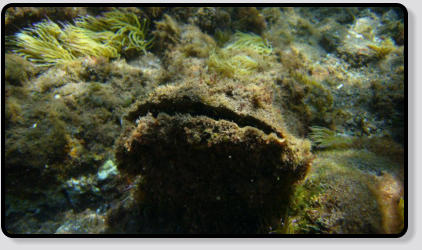
Spondylus senegalensis is a species of Bivalves Spondylidae. The scientific name of the species is valid for the first time published in 1793 by
Schreibers.
No further information available on Wikipedia.
Description
Animalia
Scientific classification
Kingdom:
Phylum:
Mollusca
Class:
Gastropoda
Order:
Na.
Family:
Trochidae
Genus:
Osilinus
Species:
O. Atrata
Osilinus Atrata
Binomial name




Top Shell
Osilinus Atrata
Burgado
Burgado Hembra
Maagdenpalm Schelp
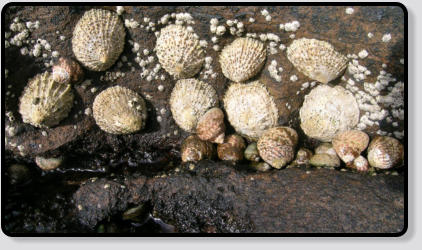
No further information available on Wikipedia.
Description
Animalia
Scientific classification
Kingdom:
Phylum:
Mollusca
Class:
Gastropoda
Order:
Na.
Family:
Patellidae
Genus:
Patella
Species:
P. Candei
Patella Candei Crenata
Binomial name




Black Limpet
Patelle Noire
Napfschnecke
Lapa Negra
Schroef Schelp
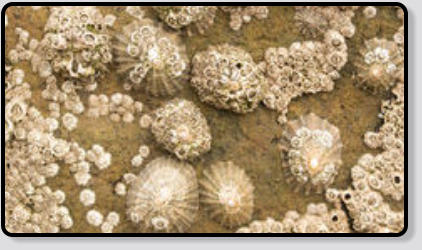
No further information available on Wikipedia.
Description
Animalia





Harry van Goor 2016
source: Wikipedia, the free encyclopedia


Categories: Mussels, Oysters & Shells






Scientific classification
Kingdom:
Phylum:
Arthropoda
Class:
Na.
Order:
Lepadiformes
Family:
Lepadidae
Genus:
Lepas
Species:
L. Anatifera
Binomial name (link Wikipedia)




Grosse Barnacle
Lepas anatifera
Entenmuschel
Patacabra
Eenden Mossel
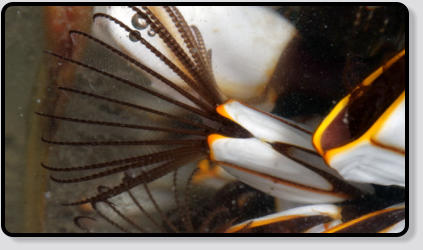
Lepas anatifera, commonly known as the pelagic gooseneck barnacle or smooth gooseneck barnacle, is a species of barnacle in the family
Lepadidae. These barnacles are found, often in large numbers, attached by their flexible stalks to floating timber, the hulls of ships, piers, pilings,
seaweed and various sorts of flotsam.
The body or capitulum of Lepas anatifera is supported by a long, flexible stalk or peduncle. There are five smooth, translucent plates, edged with
scarlet and separated by narrow gaps. The plates have growth lines parallel with their margins and a few faint radial sculpture lines. Inside the
capitulum, the barnacle has a head and thorax and vestigial abdomen. A number of brown, filamentous cirri or feeding tentacles project from
between the plates. The peduncle is tough and a purplish-brown colour. The capitulum can grow to a length of 5 centimetres (2.0 in) and the
peduncle varies between 4 centimetres (1.6 in) and 80 centimetres (31 in)
Lepas anatifera has a cosmopolitan distribution and is found in tropical and subtropical seas worldwide. Because it is often attached to objects
carried into colder seas by currents, such as the North Atlantic Drift, it is often found well away from its place of origin and in waters too cold for it
to reproduce. In this way it has been recorded from Norway, the Shetland Islands, the Faeroe Islands, Iceland and Spitsbergen.
Description
Animalia

